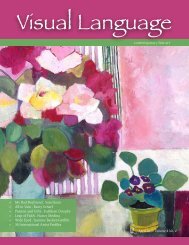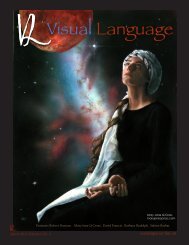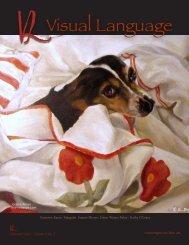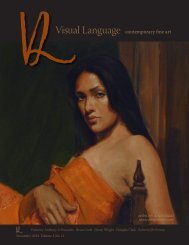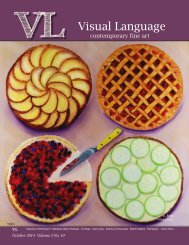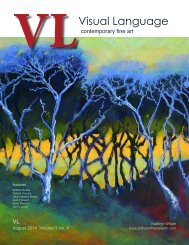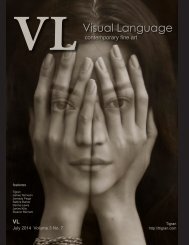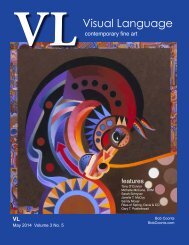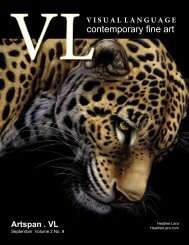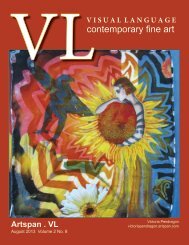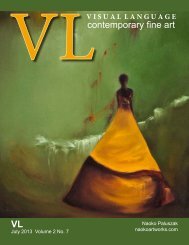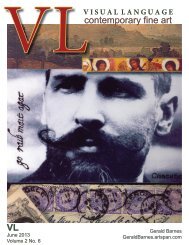Visual Language Magazine Contemporary Fine Art Vol 4 No 1
Visual Language Magazine Contemporary Fine Art Vol 4 No 1 Contemporary Modern Art, Abstract Art, Mixed Media and More. Cover Artist Andrew Baird VL Artists to Collect are Vanessa Katz, Valerie Travers and Elaine Vileria, Visual Language Studio Visits with Andy Baird, Sallie-Anne Swift, Slav Krivoshiev, Elizabeth Chapman and Demian Dressler; also included Barry W. Scharf featured writing and more. Visual Language is the common connection around the world for art expressed through every media and process. The artists connect through their creativity to the viewers by both their process as well as their final piece. No interpreters are necessary because Visual Language Magazine crosses all boundaries.
Visual Language Magazine Contemporary Fine Art Vol 4 No 1 Contemporary Modern Art, Abstract Art, Mixed Media and More. Cover Artist Andrew Baird VL Artists to Collect are Vanessa Katz, Valerie Travers and Elaine Vileria, Visual Language Studio Visits with Andy Baird, Sallie-Anne Swift, Slav Krivoshiev, Elizabeth Chapman and Demian Dressler; also included Barry W. Scharf featured writing and more. Visual Language is the common connection around the world for art expressed through every media and process. The artists connect through their creativity to the viewers by both their process as well as their final piece. No interpreters are necessary because Visual Language Magazine crosses all boundaries.
Create successful ePaper yourself
Turn your PDF publications into a flip-book with our unique Google optimized e-Paper software.
VL<br />
Andy Baird<br />
“The Value of Line”<br />
I was born in Denver, Colorado. There is a thing<br />
about being a long-time Colorado family, so I like<br />
to point out that I am a fifth-generation Colorado<br />
native. The first Baird came here in 1867. Colorado<br />
has always been my home, and I cannot think of<br />
any other place as home.<br />
I knew I would be an artist when I was seven. I used<br />
to watch my aunt paint horses, and I won a schoolwide<br />
art contest in second grade. After high school,<br />
I went to a commercial art school. I discovered a<br />
love for oils and figure painting, and I went to the<br />
University of <strong>No</strong>rthern Colorado for my degrees in<br />
<strong>Art</strong> Education.<br />
As a freshman, I ended up in graduate-level painting<br />
courses, along with a few required under-grad<br />
courses. By my sophomore year I had to catch up<br />
on required courses, one of which was ceramics.<br />
I was not happy, until I learned that ceramics involved<br />
using a wheel and kilns. I loved working on<br />
the wheel and my painting fell by the wayside. My<br />
master’s project was on Native American pottery,<br />
and I figured out the secret to Maria Martinez’s metallic-black<br />
hand-polished finish. My pots were hand<br />
polished, disassembled and reassembled, resulting<br />
in ancient look.<br />
By the time I became a high school teacher, galleries<br />
were selling my high-end pottery. Robert Redford<br />
bought my first pot sold in my Santa Fe gallery,<br />
and that got me national attention.<br />
When blown-glass overtook the pottery market,<br />
I returned to painting, always looking for current<br />
trends. When I travel, I visit galleries and look for<br />
interesting and intriguing art. I like to get the pulse<br />
of what the nation is thinking.<br />
I had a student so advanced that he needed new,<br />
challenging assignments. He made excellent contour<br />
drawings, so I asked him to “draw” a face by<br />
scribbling, without an outline, using chalk pastels.<br />
This became a standard assignment in my advanced<br />
drawing classes. I was inspired to work with<br />
the technique myself, using liquid paint.<br />
http://bairdstudios.com/<br />
My high school let me paint in an empty classroom<br />
in the summer. I spread canvases on the floor and<br />
walked on them, experimenting with different paints<br />
and tools. Dribbling paint prevented the precision<br />
needed for small subjects, so I worked on large<br />
canvases. My process evolved into walking around<br />
a stretched canvas, better control over the streaming,<br />
being able to visualize the image from a distance,<br />
and creating fun, new images. My first show<br />
was a success, so I felt that I was working on the<br />
right art at the right time.<br />
My paintings are sometimes compared to Jackson<br />
Pollack’s. Long before I started this technique, I<br />
had seen reproductions of Pollack’s paintings, and<br />
I did not care for them. After seeing Pollack’s original<br />
work, I became an absolute fan. I love how the<br />
many layers of paint create depth to his paintings.<br />
There is also a connection to Chuck Close, whose<br />
pixel-like sections compose portraits, and Georges-Pierre<br />
Seurat, who used dots of paint to compose<br />
scenes. Optical blending enables the perception<br />
of the image. I might call my work “Seurat<br />
meets Jackson Pollack meets Chuck Close”.<br />
My work is a branch of the American Pop <strong>Art</strong> tradition,<br />
similar to Warhol’s Campbell Soup cans. I<br />
talked to friends, clients, and artists, and noticed<br />
what is popular in check-out lines. That led me to<br />
deliberately work with a glamour look, almost the<br />
commercial look from fashion magazines. I follow<br />
the overall Pop <strong>Art</strong> philosophy, putting art in daily<br />
life, off the pedestal.<br />
I’m selective about the images needed for that<br />
“look”. I’m inspired by ads, photos with the right<br />
light, shade and image, or students or friends with<br />
promising faces. Whatever the source, it’s up to me<br />
to create the look of popular culture in my paintings.<br />
I also paint images of things that had a big impact<br />
on my teenage years – the Statue of Liberty, the<br />
Campbell’s Soup can. I met Andy Warhol at a show<br />
in Denver. Warhol wrote a dedication to me in a<br />
copy of his book (Andy Warhol from A to B and Back<br />
Again), “To Andy from Andy”, with a little Campbell’s<br />
Soup can drawing. Meeting him made such an impression<br />
on me, and that’s why I’m so glad to be<br />
able to exhibit the Pop art character of my work.<br />
52 | VL <strong>Magazine</strong> - <strong>Visual</strong><strong>Language</strong><strong>Magazine</strong>.com



